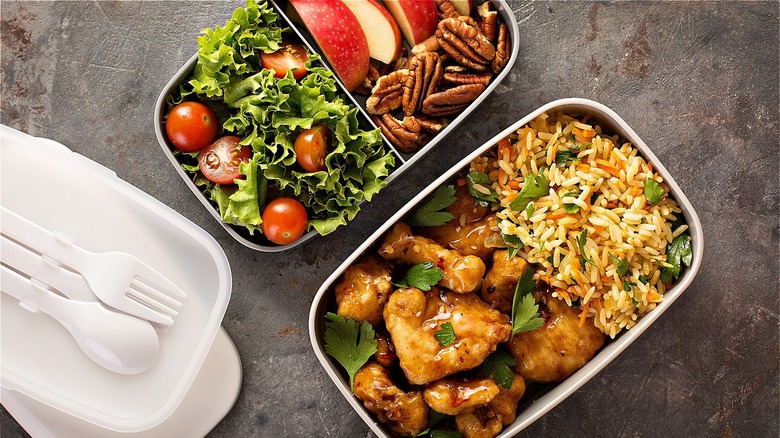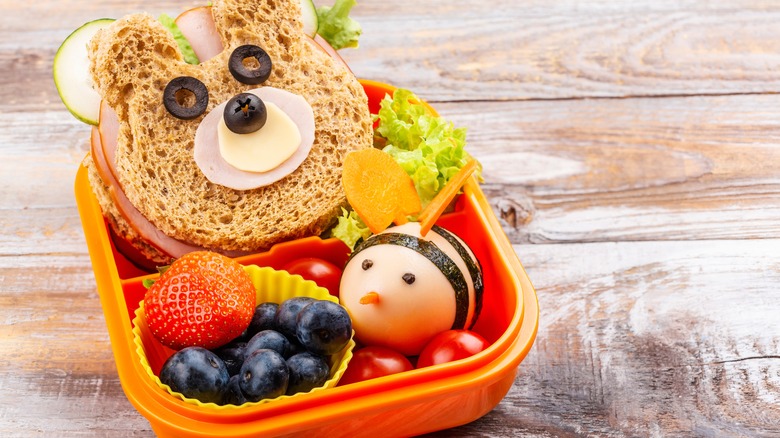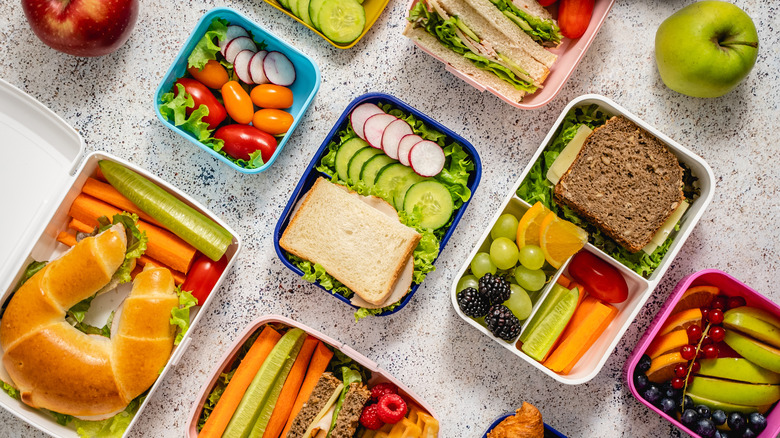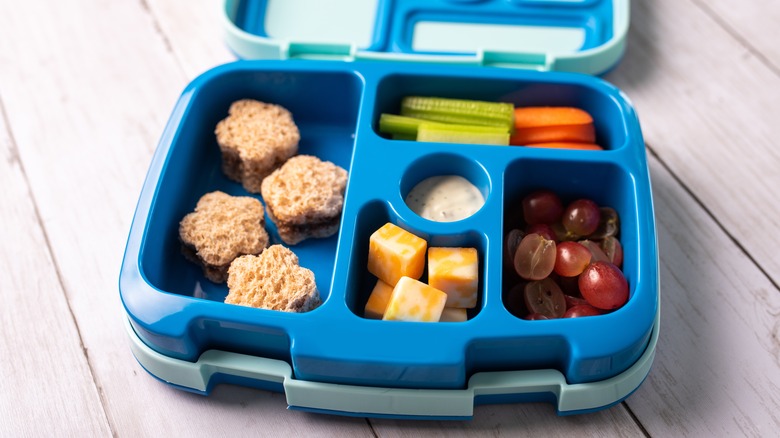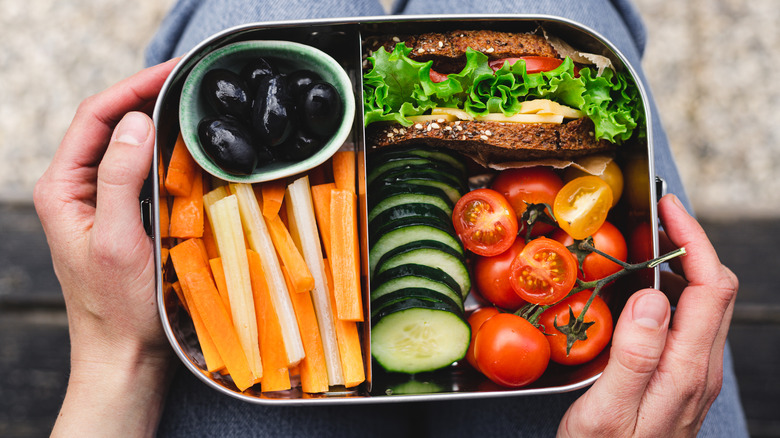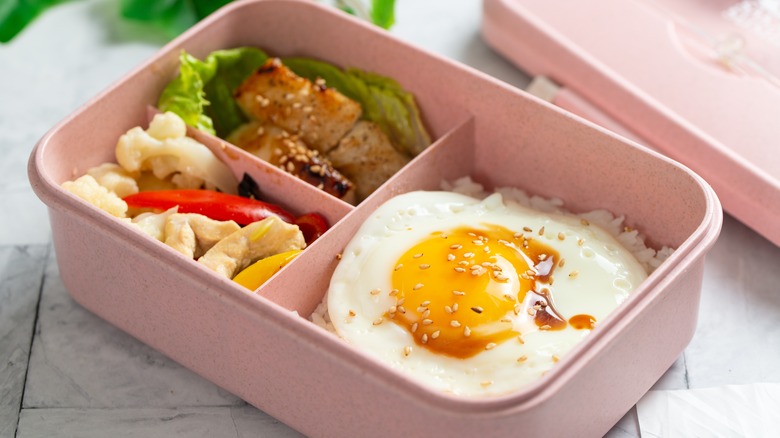Take A Cue From Japan And Start Packing Your Lunch In A Bento Box
Bento boxes are a common sight in Japanese restaurants: small trays that feature little compartments to hold food. The term, from Chinese "biàndāng," means "organized," which is exactly what bento boxes do — organize your food into compartments. People who don't like their food to touch, rejoice: Each element has its own nook or cranny. The foods you'll find in a traditional bento box include tamagoyaki, fried gyoza, rice, or a small hand roll. Bento boxes started as a way to carry rice balls during Japan's Kamakura period, from 1185 to 1333, then graduated into elaborate, lacquered wooden boxes sometime in the 16th century. Nowadays the bento box is usually made of plastic and is still a way to express creativity through food.
You've probably seen bento box school lunches popping up on social media feeds, with food artfully arranged, perhaps even an egg carved into a bunny rabbit. But they're more than just a fashionable food trend — they're a good idea for serving fresh lunches at school or in the office. Bento boxes are a step up from the brown paper bags of the 1990s — no more stale, squished peanut butter and jelly sandwiches and warm yogurt. They're an adaptable vessel for food, whether it's lunch or snacks for a road trip. Anything you or a child usually takes for lunch is appropriate for a bento box, be it a ham and cheese sandwich or last night's dinner leftovers.
Bento boxes are simple to put together by following a few guidelines
Packing a bento is like making fresher and more delicious Lunchables, especially if you're intentional when you pack it. There are a few traditional guidelines you can follow when packing a bento box lunch. Avoid food that needs to be reheated — traditional bento is meant to be eaten at room temperature. This means no greasy or heavy dishes, like curries. Lighter deep-fried foods are fine, especially if it's tempura, as it's not as greasy as a traditional Southern fried chicken leg. When packing a bento box, remember to add color and add lots of it. We eat with our eyes first, and more pops of color will make lunch look more appetizing, plus, it's healthier. So the wider you cast your net the better things will taste.
When it comes to planning a bento menu, as a rule of thumb you should include one element each of a carbohydrate, a protein, and a side. Fill in the rest of the space with colorful, flavorful ingredients, and finish off with fruit. For instance, a nice bento box lunch might include leftover pasta, carrot sticks and cucumber slices, along with some berries and a sweet snack to make for a flavorful, well-rounded meal.
Turning a traditional PB&J sack lunch into a bento-worthy lunch isn't difficult
Bento box lunches do have a little bit of whimsy to them, especially if you take the time to make them special. Don't let the bento box influencers get you down about not cutting hearts out of watermelon — so long as it's fresh and flavorful. To make compartmentalization easier, especially if you're serving foods in the same compartment, use dividers, like silicone cupcake liners, sushi grass, or even edible dividers like lettuce, carrots, and cucumber. This will keep the food fresh and separate.
When it comes to bento box meal prepping for the week, keep it simple. If you're serving a sandwich, simply cut it to size to fit into the largest compartment, or cut it into a fun shape like a cat or bear. Try to serve deconstructed foods — truly a Snackables moment. This gets you — or your kid — involved in the act of eating, even if it's dipping cucumber slices into ranch dressing or spooning tuna salad onto a cracker. Use your (or your kiddo's) favorite crackers and some ham and cheese slices, which you can cut into whimsical shapes using a cookie cutter, and you have a do-it-yourself ham and cheese sandwich. When you consume the elements in the box's separate compartments you have to take a moment to slow down and engage in the act of eating, rather than just scarfing it down.
Separate compartments and insulated designs keep food fresh
Some bento boxes are insulated. You can reheat a leftover, pack it in there immediately, and it'll still be warm when you get to it at lunchtime — no cold or congealed fettuccine Alfredo here. The insulated compartments also mean cold and cooler food stays at that temperature. The lids are snug-fitting, so your food stays the way it's meant to — fresh and ready to eat. This is why it's recommended that you pack the bento in the morning instead of the night before — it's an extra step and takes more time in the morning but it's worth it because your food will taste and look better. If your box isn't insulated, cool down any reheated food before packing so it doesn't affect other foods in the box. It's also a good idea to keep a small ice pack in the lunch bag.
The compartments allow for food to remain separate, so you're not sullying a whole compartment with juice from an orange slice or with Italian dressing. If you do need a sauce, such as ketchup or soy sauce, look into multi-use plastic containers like those that come with your sushi delivery, and use them to keep sauces separate.
Bento boxes are good for cutting down on food waste and single use plastics
By planning ahead, and doing some component cooking, you can really capitalize on the benefits of packing your lunch in a bento box. They're eco-friendly because they're endlessly reusable. This means you're not using all those single-use plastics like sandwich baggies and plastic containers that many of us use to transport lunches to school or the office. As a bonus, bento boxes often come with their own set of utensils. You can bring these home to wash, eliminating the need to use single-use plastic utensils or that questionable fork in the office kitchen drawer. You can also buy these utensils separately if your bento box didn't initially include them.
Besides being eco-friendly, bento boxes are economical because you're more likely to use up your leftovers or pack exactly as much of something as you intend to eat. You reduce food waste and stop letting money rot in the back of your fridge — because food is expensive nowadays. Leftovers are always a good idea for lunch if you're trying to curb your lunchtime spending and food waste, so it's a win-win. And by carefully packing smaller amounts of a variety of foods, you can look forward to a varied satisfying meal without excess you want to toss in the trash.
Look for bento boxes online, but there are some considerations
You can find bento boxes online, usually on Amazon, or on specialty sites like Kyoto-based Bento&co, which specializes in bento boxes and accessories. There are a lot of options when it comes to materials — wooden boxes such as bamboo, as well as lacquered wooden boxes, plus plastic, metal, and glass are all available. It just depends on your preferences. Also, consider what you'll be using the boxes for — do you need a lot of food, or not so much? Would you prefer a modular, mix-and-match system or a bento box with predetermined compartments? Do you need to keep food hot or cold? If you're going to be using the box on the daily, look for something that can stand up to daily washings and trips to and from the office.
Before investing in a bento box system, take a moment to peruse the best bento boxes to buy, and think about the meals you'd like to pack, to get a feel for what might work for you.
